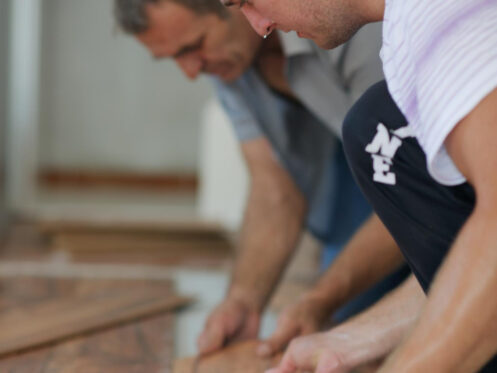Recognizing the early warning signs of a slab leak can save you thousands in repair costs and prevent structural damage to your home.
Slab leaks are silent troublemakers that develop underneath your home’s concrete foundation. Unlike obvious plumbing problems, these leaks often go unnoticed until they’ve caused significant damage.
When water pipes beneath your foundation crack or break, they create what’s known as a slab leak – a serious issue that requires prompt attention.
We often see homeowners confused by unexplained increases in water bills, mysterious warm spots on their floors, or the sound of running water when no fixtures are in use. These subtle clues shouldn’t be dismissed as they typically point to a developing problem beneath your foundation.
We understand how easy it is to overlook these hidden signs, especially when they develop gradually. Most homeowners don’t realize that what seems like a minor issue could indicate a serious problem underneath their feet. By the time obvious symptoms appear – like standing water or foundation cracks – the damage is often extensive and costly to repair.
In this article, you’ll learn how to spot the early signs of a slab leak before they cause costly damage to your home’s foundation.
Let’s break down the key points you should consider:
- What is a slab leak and why does it happen?
- Early signs your slab might be leaking
- Physical changes and structural red flags
- What happens if you ignore a slab leak?
- Professional slab leak detection and repair in Orange County
Good reading.
What is a slab leak and why does it happen?
A slab leak occurs when water pipes beneath your home’s concrete foundation develop breaks or cracks, causing water to leak under your house. These hidden leaks can waste thousands of gallons of water and cause serious damage to your home’s foundation if left undetected.
Pipes under your foundation: How they work
Most modern homes are built on concrete slab foundations with a network of water pipes running underneath. These pipes deliver water throughout your home for showers, sinks, and appliances.
In a typical setup, two main types of pipes run under your slab: copper water supply lines (delivering clean water) and drain lines (carrying waste water away).
These pipes are installed before the concrete is poured. When your home was built, plumbers laid these pipes in trenches dug into the soil, then the concrete foundation was poured over them.
This construction method keeps pipes protected but makes them difficult to access when problems develop. Regular maintenance is crucial because repairs often require breaking through concrete.
Common causes of slab leaks in California homes
Several factors make California homes particularly vulnerable to slab leaks:
- Soil movement: California’s clay soils expand and contract with moisture changes, putting pressure on pipes.
- Earthquakes: Even minor seismic activity can damage or weaken plumbing connections.
- Poor water quality: Hard water with high mineral content accelerates pipe corrosion from the inside.
- Improper installation: Pipes that weren’t properly installed may rub against concrete or rocks.
- Aging pipes: Many California homes built in the 1950s-1970s used copper pipes that are now reaching the end of their lifespan.
Water pressure that’s too high can also stress pipes over time. We recommend installing pressure regulators if your home’s water pressure exceeds 80 PSI.
The hidden danger of slow leaks beneath concrete
Slab leaks are particularly dangerous because they often develop slowly and remain hidden for months.
Even a pinhole-sized leak can release gallons of water daily, saturating the soil beneath your home. This persistent moisture creates several serious problems:
- Foundation damage as water erodes the soil supporting your home
- Mold and mildew growth in dark, damp areas
- Increased water bills from constant water waste
- Cracked tiles or warped flooring as moisture pushes upward
The longer a slab leak continues, the more extensive and expensive the damage becomes. A small repaircan quickly turn into a major renovation project.
Early detection is critical. Watch for warm spots on your floor, the sound of running water when no fixtures are in use, or unexplained increases in your water bill.
Early signs your slab might be leaking
Slab leaks often reveal themselves through subtle changes in your home before major damage occurs. Catching these early warning signs can save you thousands in repair costs and prevent structural damage to your property.
Unexplained rise in water bills
A sudden spike in your water bill is often the first red flag of a slab leak. When water continuously leaks beneath your foundation, your meter keeps running even when all fixturesare turned off.
Check your bill against previous months. A 20-30% increase without changes in usage patterns deserves attention.
To verify if a leak exists, turn off all water-using appliances and fixtures in your home. Then check your water meter. If the dial continues to move, water is escaping somewhere in your system.
Many homeowners dismiss higher bills as seasonal changes, but persistent increases warrant professional investigation. The sooner you address this sign, the less water you’ll waste and money you’ll spend.
Warm or damp spots on your floors
Hot water line leaks create noticeably warm areas on your floor. These warm patches often feel unusual when walking barefoot across tile, wood, or carpet.
Cold water line leaks manifest as damp or wet spots. You might notice:
- Discoloration on flooring
- Warping in wood floors
- Carpet that feels consistently moist
- Baseboards that show water damage
Pay special attention to corners and areas near bathrooms and kitchens. Use your hand to feel for temperature differences across your floor. Inconsistent temperatures in specific spots rarely have innocent explanations.
Don’t ignore these symptoms, as moisture beneath your slab will eventually compromise your foundation’s integrity and create costly structural issues.
Mold, mildew, or musty smells near walls
According to the U.S. EPA’s leak detection checklist,“Check for signs of moisture or mold on your walls, ceilings, or floors. This could indicate that a pipe is wreaking havoc behind the scenes and requires the attention of a professional.”
The persistent moisture from slab leaks creates perfect conditions for mold and mildew growth. These fungi thrive in damp, dark environments like the space between your walls or under flooring.
Watch for visible mold growth along baseboards or the bottom of walls. Black, green, or white spotting indicates a moisture problem.
Musty odors often appear before visible mold. If rooms smell damp despite regular cleaning, investigate further. These smells are particularly noticeable in closed spaces like closets near affected areas.
Health symptoms like increased allergy reactions, respiratory issues, or headaches when in specific areas of your home can also indicate mold from a slab leak. We recommend checking humidity levels in suspicious rooms, as readings above 60% support mold growth.
Sounds of water running when pipes are off
One of the most telltale signs of a slab leak is hearing water flowing when all fixtures are turned off. This phantom sound indicates water escaping from pressurized pipes.
Listen carefully near floors, especially at night when your home is quiet. A faint hissing, rushing, or trickling sound suggests water moving where it shouldn’t be.
Modern detection equipment can pinpoint these sounds precisely, but your ears provide the first alert. If you hear:
- Constant running water sounds
- Bubbling or gurgling from drains
- Whistling from pipes
These acoustic clues should prompt immediate investigation. Water continuously running puts pressure on your plumbing system and wastes significant amounts of water daily.
Physical changes and structural red flags
Your home’s foundation speaks through physical signs when water damage occurs beneath it. These visible changes often appear before serious damage takes hold, giving you a chance to act quickly.
Cracks in walls or flooring that seem sudden
Cracks that appear in your walls or flooring without explanation are one of the most obvious signs of a slab leak. These cracks often start small but can quickly grow larger as water continues to erode the foundation.
Look for hairline cracks that form in patterns, especially around doorways or windows. These areas show stress first when foundation movement occurs.
Floor cracks deserve special attention, particularly if they appear alongside uneven sections of flooring. When water accumulates under your foundation, it can cause parts of the slab to sink or rise.
Wall cracks that run diagonally often indicate foundation movement. We recommend taking photos of any cracks you find to monitor their growth over time.
Don’t dismiss small cracks as normal settling. New homes settle gradually, but sudden crack formation suggests an active problem beneath your feet.
Baseboards that pull away from walls can also signal foundation movement from a slab leak. This happens as moisture warps the surrounding materials.
What happens if you ignore a slab leak?
Ignoring a slab leak can lead to severe consequences that affect both your home’s structure and your wallet. The damage often compounds over time, creating problems that extend far beyond a simple water leak.
Structural damage and foundation shifting
Foundation damage is one of the most serious consequences of an untreated slab leak. When water continuously seeps into the soil beneath your foundation, it can cause the soil to expand or wash away completely.
This soil movement creates instability, leading to foundation shifting and settling. You might notice cracks in walls, uneven floors, or doors that no longer close properly.
In extreme cases, foundation shifting can compromise your entire home’s structural integrity. Support beams may become unstable, and load-bearing walls can develop dangerous weaknesses.
The longer the leak continues, the more extensive the foundation damage becomes. What starts as a minor shift can develop into major structural problems requiring extensive repairs.
Risk of mold and air quality issues
Water from slab leaks creates the perfect environment for mold growth. These damp conditions beneath your home can lead to extensive mold colonies that are difficult to detect until they’ve spread significantly.
Mold doesn’t just damage your home’s structure—it poses serious health risks. People with allergies, asthma, or respiratory conditions are particularly vulnerable to health issues from mold exposure.
Common symptoms include:
- Persistent coughing or wheezing
- Eye irritation
- Skin rashes
- Chronic headaches
- Fatigue
The longer a slab leak persists, the more widespread mold growth becomes. Eventually, it can affect your entire home’s air quality, making the environment unhealthy for everyone.
Professional remediation becomes necessary once mold takes hold, adding another expensive repair to your growing list.
Higher repair costs the longer you wait
Small slab leaks rarely stay small. What begins as a minor issue can quickly escalate into a major repair project with substantial costs.
Initial repair costs for a promptly addressed slab leak might include:
- Leak detection services: $150-$400
- Basic pipe repair: $500-$1,000
- Minor concrete work: $300-$500
When ignored, these costs multiply dramatically:
- Extensive plumbing replacement: $2,000-$10,000
- Foundation repairs: $5,000-$25,000
- Mold remediation: $2,000-$6,000
- Water damage restoration: $1,000-$5,000
The financial burden increases exponentially with time. What could have been a manageable expense becomes a major financial hardship when the problem is allowed to progress.
Insurance complications and coverage limits
Many homeowners assume their insurance will cover slab leak damage, but the reality is more complicated. Most policies have specific limitations when it comes to slow, ongoing leaks.
Insurance companies typically distinguish between sudden accidents and ongoing neglect. If they determine you ignored warning signs for an extended period, they may deny your claim entirely.
Even with coverage, most policies have caps on how much they’ll pay for slab leak repairs. These limits often fall well below the total cost of extensive damage.
Some policies require additional riders specifically for slab leak coverage. Without these riders, you might find yourself with minimal or no coverage when you need it most.
We recommend reviewing your policy details carefully and understanding exactly what’s covered before a problem occurs. This preparation can prevent unpleasant financial surprises during an already stressful situation.
Professional slab leak detection and repair in Orange County
Orange County homeowners have access to specialized services that can quickly locate and fix slab leaks before they cause extensive damage. Professional detectionuses advanced technology to identify leaks with minimal disruption to your property.
How Splash Plumbing uses non-invasive detection methods
At Splash Plumbing,we utilize cutting-edge equipment to detect slab leaks without damaging your property. Our electronic leak detectiontools can pinpoint the exact location of water leaks underneath concrete slabs.
We employ ultrasonic listening devices that can hear the sound of water escaping from pipes, even through thick concrete. This technology allows us to locate leaks with remarkable accuracy.
Thermal imaging cameras help us identify temperature differences in your flooring that indicate water leakage. These non-invasive methods mean we don’t need to break up large sections of concrete to find the problem.
Our pressure testing equipment confirms leak locations by measuring changes in water pressure throughout your plumbing system. This comprehensive approach ensures we find the source of the problem quickly.
What to expect during a slab leak repair service
When you schedule a repair with us, we begin with a thorough assessment of the leak’s location and severity. We’ll explain all available repair options and provide a detailed cost estimate before starting any work.
The repair process typically involves:
- Creating a targeted access point to reach the damaged pipe
- Repairing or replacing the affected section
- Pressure testing to ensure the fix is complete
- Restoring the concrete and flooring materials
Most slab leak repairs take 1-2 days to complete, depending on the complexity and accessibility of the leak. We work efficiently to minimize disruption to your home and daily routine.
Our technicians clean up thoroughly after completing repairs, leaving your property in excellent condition. We also provide recommendations to prevent future slab leaks.
Emergency response vs planned intervention
We offer 24/7 emergency response for active slab leaks causing immediate damage to your home. Our Orange County emergency teams can typically arrive within 60-90 minutes to assess the situation and stop water damage.
Emergency repairs focus first on stopping water flow to prevent further damage. We may implement temporary solutions before scheduling a permanent fix.
Planned interventions allow for more thorough preparation and often result in more cost-effective repairs. If you notice subtle signs like higher water bills or warm spots on your floor, scheduling a planned inspection can prevent emergency situations.
The cost difference between emergency and planned repairs can be significant. Emergency services include after-hours rates, while planned repairs can be scheduled during standard business hours at regular rates.
Conclusion
Slab leaks represent a serious threat to your home’s structure and your finances. By recognizing the warning signs early, you can prevent extensive damage and costly repairs.
We’ve seen how unexpected increases in water bills, damp spots on floors, warm areas on your foundation, and musty odors can all indicate a hidden leak beneath your home. These signals should never be ignored.
Taking quick action when you notice these symptoms is crucial. Document any changes with photos and notes to share with a professional plumber when they inspect your home.
Remember that small leaks can quickly become major problems that threaten your property’s value and your family’s safety. Early detection is your best defense against thousands of dollars in repair costs.
If you suspect a slab leak, contact a licensed plumber immediately. Professional detection and repair services will save you money and stress in the long run.
By staying vigilant and responding promptly to the warning signs we’ve discussed, you can protect your home from the hidden dangers of slab leaks.
If you notice any signs of a slab leak, contact Splash Plumbing today to schedule an inspection and protect your foundation from costly damage












